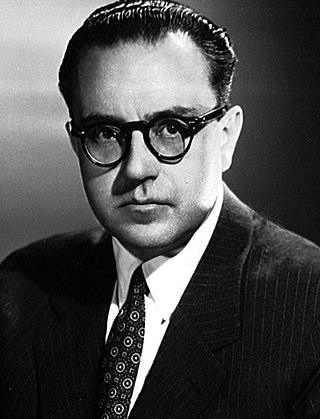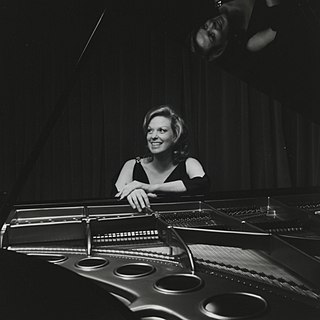Related Research Articles
Sonata form is a musical structure generally consisting of three main sections: an exposition, a development, and a recapitulation. It has been used widely since the middle of the 18th century.
In music, variation is a formal technique where material is repeated in an altered form. The changes may involve melody, rhythm, harmony, counterpoint, timbre, orchestration or any combination of these.

Alberto Evaristo Ginastera was an Argentine composer of classical music. He is considered to be one of the most important 20th-century classical composers of the Americas.
Cyclic form is a technique of musical construction, involving multiple sections or movements, in which a theme, melody, or thematic material occurs in more than one movement as a unifying device. Sometimes a theme may occur at the beginning and end ; other times a theme occurs in a different guise in every part.

Murray David Perahia is an American pianist and conductor. He is widely considered one of the greatest living pianists. He was the first North American pianist to win the Leeds International Piano Competition, in 1972. Known as a leading interpreter of Bach, Handel, Scarlatti, Mozart, Beethoven, and Schumann, among other composers, Perahia has won numerous awards, including three Grammy Awards from a total of 18 nominations, and 9 Gramophone Awards in addition to its first and only "Piano Award".

Ferdinand Ries was a German composer. Ries was a friend, pupil and secretary of Ludwig van Beethoven. He composed eight symphonies, a violin concerto, nine piano concertos, three operas, and numerous other works, including 26 string quartets. In 1838 he published a collection of reminiscences of his teacher Beethoven, co-written with Beethoven's friend, Franz Wegeler. Ries' symphonies, some chamber works—most of them with piano—his violin concerto and his piano concertos have been recorded, exhibiting a style which, given his connection to Beethoven, lies between the Classical and early Romantic styles.
E major is a major scale based on E, consisting of the pitches E, F♯, G♯, A, B, C♯, and D♯. Its key signature has four sharps. Its relative minor is C-sharp minor and its parallel minor is E minor. Its enharmonic equivalent, F-flat major, has six flats and the double-flat B, which makes it impractical to use.

Joseph Johann Baptist Woelfl was an Austrian pianist and composer.
D major is a major scale based on D, consisting of the pitches D, E, F♯, G, A, B, and C♯. Its key signature has two sharps. The D major scale is:

Anton Franz Josef Eberl was an Austrian composer, teacher and pianist of the Classical period. He was a student of Salieri and Mozart. He was also seen as an early friend and rival of Beethoven.
Atsuko Seta is a Japanese classical pianist. She is particularly successful in Poland, especially in the southwest of the country, regularly performing with the Sudeten Philharmonic Orchestra in Walbrzych and in her native Japan and in Bulgaria. Seta is living in Poland as a Honorable Citizen of Szczawno-Zdroj city. Artistic Director of Chiangmai Ginastera International Music Festival. Honorary Professor of Payap University Thailand. Honorary Chairman of Japan Ginastera Association.

Carol Rosenberger is a classical pianist. In 1976, Rosenberger was chosen to represent America's women concert artists by the President's National Commission on the Observance of International Women's Year. She has given performance workshops for young musicians on campuses nationwide. Rosenberger recorded over 30 albums on the Delos Productions, Inc. recording label. Rosenberger's memoir, To Play Again: A Memoir of Musical Survival was published in 2018 by She Writes Press.
Olli Mustonen is a Finnish pianist, conductor, and composer.
Albert Tiu is a classical pianist from the Philippines.

Barbara Nissman is an American pianist. She is especially known for her interpretations and performances of the works of Alberto Ginastera and Sergei Prokofiev which feature prominently in her repertoire. She is also a writer and a producer of a new DVD series, and a guest clinician presenting concerts, master classes and lectures world-wide.
The Concerto for Orchestra is an orchestral composition in five movements by the American composer Jennifer Higdon. The work was commissioned by the Philadelphia Orchestra with contributions from the National Endowment for the Arts, the Philadelphia Music Project, and Peter Benoliel. It was premiered at the Kimmel Center for the Performing Arts in Philadelphia June 12, 2002, with conductor Wolfgang Sawallisch leading the Philadelphia Orchestra.
Popol Vuh: The Creation of the Mayan World, Op. 44, is a symphonic poem in seven movements by the Argentine composer Alberto Ginastera. The work, which remains unfinished, was composed between 1975 and 1983. It was first performed by the St. Louis Symphony under the direction of Leonard Slatkin at Powell Hall in St. Louis on April 7, 1989.
The bassoon repertoire consists of pieces of music composed for bassoon as a principal instrument that may be performed with or without other instruments. Below is a non-exhaustive list of major works for the bassoon.
References
- 1 2 3 Ginastera, Alberto (1972). "Piano Concerto No. 2 op. 39". Boosey & Hawkes . Retrieved April 21, 2017.
- 1 2 Corbin, Patrick (March 23, 1973). "ISO Features World Premiere". The Indianapolis Star . p. 36.
- ↑ Farach-Colton, Andrew (January 2017). "GINASTERA Piano Concerto No 2. Panambí". Gramophone . Retrieved April 21, 2017.